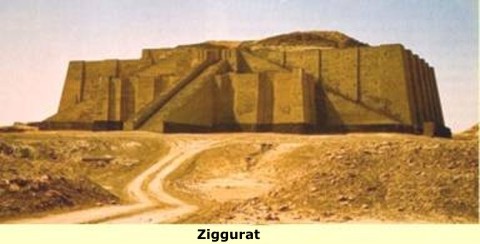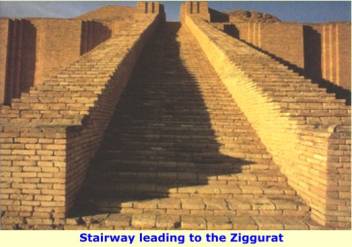The main cities of Sumer were Kish, Uruk (in the Bible, Erech), Ur, Sippar, Akshak, Larak, Nippur, Adab, Umma, Lagash, Bad-tibira, Larsa and others. Each of these City-states was comprised of a walled city and its surrounding villages and land. Each city worshiped its own deity, whose temple was the central structure of the city. Political power originally belonged to the citizens, as rivalry and wars between the various city-states increased, each adopted the institution of kingship, so as to have ready and permanent leadership when crisis arose.
 |  |  |
Ziggurats
Unlike the Egyptians, the Sumerians did not build pyramids, instead they built Ziggurats. These Ziggurats were huge structures, made of brick and comparable in size to a pyramid. In appearance they resembled a step pyramid. But they were not tombs, these were temples, sometimes with terraces planted with trees, scrubs and flowers. Similar in use to pyramid temples in the Americas. <<Click here for details and pictures of a Ziggurat>>
Pretty much all that we know of early Sumerian dynasties, is from Sumerian epic stories and the Sumerian king list, (written about 2100 B.C.). According to this king list - one of the earliest historical documents - eight kings of Sumer reigned before the famous flood of old testament fame.
A great Part of the method of dating this civilization is through the archeological record of a great flood of the Euphrates River, which happened at about 3200 B.C. This is very risky science though. For it is more likely that the flood the Sumerians were referring to in their kinglist, was an Ocean flood. Which raised the water level of the Gulf and submerged cites on the coast.
 |  |
Sumerian Prehistory
Note should be taken: In the Sumerian king list, after listing the kings names and length of reign, we get the following summary: In 5 cities 8 kings; they ruled for241,200 years, then the flood swept over. {as always when dating these first civilizations, we are on shaky ground!} - we don't know what to make of those rather fantastic numbers, but they have spurred some really interesting religious cults around the world.
It is in the Sumerian story, the "Epic of Gilgamesh" that we are first introduced to "Noah" and the great flood. {We should note at this time, that Sumer is the original home of some of the people, who will later become known as the Hebrews}. Consequently there will be similarities between Sumerian stories and Hebrew stories.


It is indicated in the king list, that after the flood various city-states through war, became the temporary seat of power. Until about 2,800 B.C, when they were united under the rule of one king, Jucur of Kish. Nothing is known of the first sixteen kings of Jucur's dynasty, until Etana, the seventeenth king. It was he, who according to the ancient Sumerian - epic of Etana - with the aid of an Eagle that he had helped, was carried high up into the sky. Etana reached heaven and prostrated himself before the gods, (the tablet is broken, so we don't know how the story ends).


In any event, unity was never a permanent thing with Sumerians, first one king of a city would gain power by defeating the others, thus making himself king of all the lands, then the next king of another city would do the same, etc etc.
Continuing from the king list: Etana's dynasty was defeated by Meckiajgacer, king of E-ana. He was succeeded by his son Enmerkar (2,650 B.C.). It is apparently under the reign of Enmerkar, that the people of E-ana build themselves a new city and named it Unug/Uruk.
| It is at about this time that the famous "Standard of Ur" was supposedly made: Click here for pictures and information on the Standard. <<Click>> |

As priest-king, Enmerkar is the Ensi (city king), of Uruk and the ritual husband of the Great Goddess Inanna. Enmerkar has as his epithet "he who build Uruk", and he is known from two epic stories, Enmerkar and the Lord of Arratta, and Enmerkar and En-suhgir-ana.
There is no known inscription or plaque that bears his name, so there is no archeological proof of his existence, other than the tablet texts of the epic stories. These tablet texts, refer to commercial and military contacts with a city called Aratta, (probably in modern day Iran), where the Sumerian goddess Inanna, and the god "Dumuzi" were worshiped. This could mean that the people of Aratta were also Sumerian. These epics are seen as proof of trade contacts with other lands. Enmerkar was the first king, according to legend, to write on clay tablets.
| Note: The following is for casual interest only. The Bible is a Religious Book, not a History Book, the following relates to a Biblical story. |
According to the researcher, David Robl: The original story of the Tower of Babel, may describe the last phase of the building of the great temple for the god Enki at Eridu, (biblical Babel). Which was begun in this Uruk Period { this is the archaeological era, which has been argued as being the time immediately following the biblical Great Flood}.
The Tower of Babel
It was in this era, that a massive platform was built over the original shrine of Enki, and the building of a new temple begun, on top of this platform. This was the first platform-temple to be built in Mesopotamia, and the prototype of the later stepped platform-temples which we know as the Ziggurats. When finished, it towered above the surrounding countryside, and was certainly a major architectural innovation. Robl believes that the biblical king Nimrod, son of Cush, was in fact king Enmerkar.
 |
He continues: Cush (biblical son of Ham and grandson of Noah), fathered Nimrod, who was the first potentate on earth. Hence the saying, 'Like Nimrod a mighty hunter in the eyes of Yahweh'.
Biblically, the mainstays of Nimrods Empire were Babel, Erech and Akkad (Agade), all of them in the land of Shinar. Shinar is (biblical ancient Sumer), Akkad was the capital of the later Akkadian empire, (that city is still to be located). Biblical Erech is Uruk, and Babel, as we have seen, originally referred to Eridu.
But Nimrod himself has always eluded identification - until now. The trick was to realize that the element 'kar' in Enmerkar was the Sumerian word for 'hunter'. Thus the name consists of a nomen plus an epithet - Enmer 'the hunter'. This was precisely the epithet in Genesis, used to describe Nimrod.
The next step was straightforward. Ancient Hebrew was originally written without vowels (as in the Dead Sea Scrolls). Vowel indicators were only added to the Masoretic manuscripts, from the 5th century A.D, onwards. So in early copies of Genesis the name Nimrod would simply have been written "nmrd". The name Enmer would also have been transcribed into Hebrew as 'nmr' - identical to Nimrod but for the last 'd'.
The Bible is well known for its play on words. Hebrew writers often translated foreign names into familiar Hebrew words, which they felt had appropriate meaning. In this case, they changed Sumerian 'nmr' to Hebrew 'nmrd', because the latter had the meaning 'rebel' - a perfect description for the king who defied God, by building a tower up to heaven.
No comments:
Post a Comment